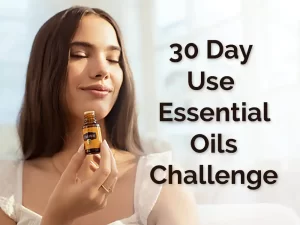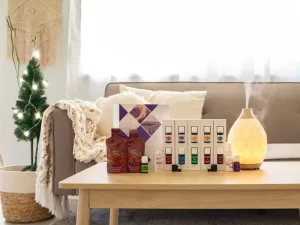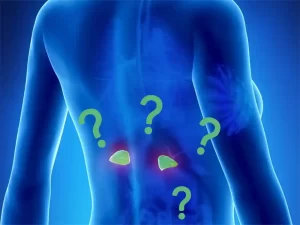The short answer is – I only use and recommend Young Living Essential Oils and oil-infused products. The long answer is… well, I’m a Certified Clinical Aromatherapist, so you know I didn’t come to that conclusion without some good reasons. Here they are!
I want to start answering this question by explaining that ‘Therapeutic grade essential oils’ is actually a term that Gary Young started using when he first founded Young Living 25 years ago. He used it to differentiate the essential oils he was producing from the ones he had previously bought in health food shops and supermarkets. Gary wanted people to know that there were essential oils produced for the perfume industry and for food flavouring. Even amongst the essential oils being marketed for use in healing work, there was still a difference in their level of quality.
These days every essential oil company has started using the term. But, there’s no governing body for essential oils checking to see if the essential oils that are labelled as Therapeutic Grade actually are of a high standard. So the term is virtually useless! Consequently, don’t get me started on the registered trademarking of the use of this term by another essential oil company.
So, which essential oils do I recommend?
Trust me, I know that it can be incredibly confusing and difficult to find really good quality essential oils when everyone is telling you that their’s are the best. I’m not going to do that. Instead I’m going to tell you to use your own intuition or what us Aussie’s call ‘gut instinct’. If you do this, the right essential oil company will resonate with you. You will smell their essential oils and know which are right for you and your family.
Over the last 10 years that I have been using essential oils, especially given that I am a Certified Clinical Aromatherapist, I’ve been approached by numerous companies to use their essential oils. I have always resonated with Young Living, both their essential oils and the company ethos. But, I’ve been told and read online some absolutely outrageous stories about Gary Young and Young Living in those 10 years.
Seeing IS believing
However, I’ve had the privilege of actually meeting Gary on a number of occasions. I’ve also visited many of the Young Living farms and partner farms around the world. I have seen these things with my own two eyes and for me seeing is believing. The standards that Young Living hold their own farms, their partner farms and their Certified Suppliers to are above any other company on the market.
It is about finding your own truth and again I will say, “what resonates with you”. I know what is best for my family, what is best for the my clients in my aromatherapy practice and what is best for me. And you will know the difference too when you start using them. Eventually even your nose will recognise the disparity between quality and adulterated oils. Especially when it comes to oils such as Lavender, Frankincense, Sandalwood and Rose – essential oils that are often adulterated.
You test which essential oil smells ‘real’
The reality is pure Rose oil doesn’t smell like a dozen roses. Unless some synthetic fragrance has been added so it smells that way! I’m going to put my money where my mouth is and make you an offer. Test it for yourself. If you would like to try Young Living’s Lavender essential oil I would be happy to send you a sample. Just send me an email and I’ll happily pop one in the mail.
If you would like to know more about Young Living’s farms here is short video showing you where some of them are.

What are Essential Oils?
Essential oils are the volatile liquids of the plant. They are obtained from properly distilling any part of the part including the seeds, roots, bark, stems, leaves, fruit, flowers or branches!
There are many factors that make a good quality pure essential oil, but all of them really fit into two main categories.
Here they are:
- Environmental Factors – Where the plant is grown; the soil type; fertilizer (organic vs. chemical); altitude, etc; and
- Physical Factors – How and when the plant is harvested, how it is distilled and even how it is bottled!
What are Chemotypes?
Many plants have a number of different chemotypes. A chemotype (CT) is a designation that tells you that the species has different chemical constituents. This usually occurs because the plant is grown in a different area of the world or a distinct climate that alters the chemistry of the plant!
So if I grow a Thyme plant in my back yard and distill it, it will have totally different chemical constituents than the one that was cultivated in the valleys of France!
How do I know what Constituents of Essential Oils are in my Thyme Oil? Essential Oil chemistry will tell you what is in the plant or oil and then that will help determine what medicinal properties your oil has!
What is Essential Oils Chemistry?
The chemistry of essential oil is determined by a piece of laboratory equipment called a gas chromatography or GC. If we take Thyme essential oil and analyze it by GC during the fall season it will contain 60-70% thymol and therefore it is called Thymus vulgaris CT thymol.
If we test the same thyme oil harvested during the spring the constituents are different and it is actually called Thymus vulgaris CT p-cymene! So, it is different oil and has different medicinal properties!
Now let me get back to our Thyme – back yard variety….
If I don’t send the distilled oil off to a specific laboratory that tests for essential oils to find out what is in it, I really have no clue what medicinal properties it has!
I make a point of this because many companies, do not test the oil and the oils are not labelled with genus species or chemotype information either. So what is it that you are really getting?
So our Thymus vulgaris CT Back Yard is great for our salad, but not necessarily great for our healing work!
How do I link the Constituents of Essential Oils to the Medicinal Property? There are various classes of compounds that make up essential oils. The two main groups of compounds are called hydrocarbons and oxygenated hydrocarbons. It is the sub-categories such as ketones, esters and phenols that really tell you the medicinal properties.
Are there Standards for Testing Essential Oils?
Unfortunately in Australia and the United States there are no standards for testing therapeutic grade essential oils. So labelling is unreliable and in fact can be deceptive. Thyme can be simply labelled generically with no scientific name or chemotype. So what is it really?
However, the Europeans, Asians and the Middle Eastern cultures who have been using essential oils and botanical extracts for thousands of years do have some guidelines! And the companies who are serious about providing real therapeutic grade essential oil to their customers test their batches and use those standards.
The Association French Normalization Organization Regulation (AFNOR) standards or ISO certification (ISO standards) has the most reliable chemical constituent indicators of whether oil is therapeutic or not.
However, no organization regulates whether a company is meeting those standards or not; so it is up to the company to test each batch of distilled oil to make sure that it meets the standard! As you can imagine testing is very costly in addition to the harvesting and distillation costs. As a matter of fact, the GC equipment isn’t standard equipment either. It must have a column length of 50 or 60 meters to accurately determine the oil constituents according to the certification process!
What are the Methods of Extracting Essential Oils?
There are many different ways to extract essential oils and again these help separate the therapeutic grade essential oils with perfume or aromatherapy grade for sure. Carbon-dioxide extraction and distillation methods where solvents are used are commercially manufactured processes that use chemicals to enhance or quicken the distillation process. It is a less expensive process and the oils are considered adulterated (changed). These oils will still contain a portion of the solvent and can be dangerous when used for therapeutic reasons, so please be careful! This is how 98% of the manufactured essential oils including the perfume quality oils are made!
Distillation through steam is a very slow process and is carried out at low temperatures to maintain the quality and therapeutic benefits of the oil. Distillation temperatures, length of time the oil is distilled and the type of condenser used all have an enormous impact on the quality of the oil!
Why is it so Costly to Produce Therapeutic Grade Oil?
You mean besides everything you have already read about! Yes there is more!
You need hundreds of pounds of material to make a pound of therapeutic grade oil. For instance it takes 30 to 60 roses to make one DROP of pure therapeutic grade rose oil! This is the case with Melissa (Lemon Balm) Essential Oil as well. So it takes far less material to make synthetic or perfume grade oil!
Therefore producing oils correctly and for therapeutic benefits is extremely time consuming and costly! The cost of the plants alone can be enough to discourage a company from producing them. But it is worth it! The therapeutic grade essential oil is extremely concentrated and although the cost of the oil is more, we need far less and we can expect therapeutic results!
So why Young Living?
No one does all these things better than Young Living. That’s why… for all the above reasons… I only use and recommend Young Living Essential Oils and oil-infused products.
Kim xox

SaveSave
SaveSave










 Subscribe to Hot Oily Mumma
Subscribe to Hot Oily Mumma